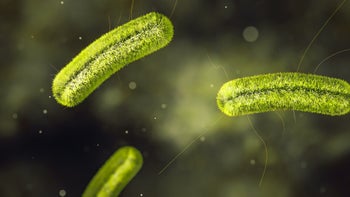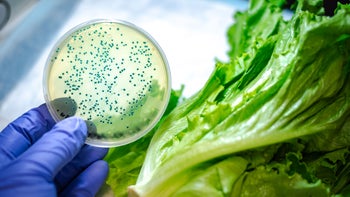
GoodRx Guide
Food Poisoning: Your GoodRx Guide
Comprehensive information for you or a loved one — including treatment options and discounts on popular medications.Definition
Food poisoning (or foodborne illness) is an infection or inflammation of the gastrointestinal tract. As many as 1 in 6 people in the U.S. will get food poisoning each year. It occurs when people come into contact with bacteria — or other germs — in their food or drink. It usually leads to symptoms of nausea, vomiting, diarrhea, and crampy abdominal pain within a few hours of exposure.
Outbreaks usually occur when food is not cooked or stored properly. This allows germs to multiply. These germs can cause an infection inside your gastrointestinal tract and make you sick. Other times, the germs can make a toxin. Your body then becomes inflamed in response to these toxins. In this instance, it may not be a true infection, but you can experience many of the same symptoms.
Causes
Food poisoning can happen when you ingest food or water that’s contaminated with germs or toxins. These contaminants can be present in areas with poor sanitation. They can also be present when:
Food is not properly cleaned or cooked thoroughly
Food is not properly stored or refrigerated
Germs are introduced into food during the manufacturing process
The more commonly contaminated foods include undercooked meat, unpasteurized milk or cheeses, and fresh produce. Bacteria, viruses, or parasites can contaminate these products. Some of the more common foodborne germs include:
Norovirus: This virus is infamous for causing food poisoning among kids in day care and on cruise ships.
Salmonella: This bacteria can occur in many different foods. Outbreaks can also happen around farms and petting zoos.
Clostridium perfringens: This bacteria is associated with raw or undercooked meat.
Campylobacter: This bacteria is also associated with raw meat. It’s the most common cause of food poisoning worldwide.
Staphylococcus aureus: This bacteria causes food poisoning through a toxin that it produces. Symptoms from Staph can start very quickly after eating contaminated foods, sometimes as soon as 30 minutes.
Symptoms
Most people with food poisoning develop an upset stomach within a few hours of exposure. Common symptoms that follow include:
Nausea
Vomiting
Diarrhea
Abdominal pain or cramps
Fever
While most people recover from their symptoms in 2 to 3 days, others may develop a more severe infection that lasts longer. People are at increased risk of a more serious infection when they have weak immune systems or are very young or very old. Their symptoms might include:
Bloody or black/tarry diarrhea
Severe abdominal pain
Severe headache or stiff neck
Confusion
Dizziness, confusion, or lethargy
Diagnosis
Most people know when they have food poisoning without seeing their provider for a diagnosis. This is not a problem because the illness often passes on its own. And, what’s more, finding the specific germ that’s causing the problem usually doesn’t change the treatment.
People who have a more serious infection may need further testing. Providers can run tests on both stool and blood samples to help figure out exactly which bacteria is causing the infection. And this can be important for people who need more treatment than just rest and hydration.
Groups that might have a higher risk of a more severe illness include:
Children younger than 5 years old
People over 65 years old
Pregnant women
People with chronic illnesses like diabetes
People with weakened immune systems, like from cancer or HIV
Things to try at home
If you’re sick with food poisoning, there are several steps you can take at home to speed up your recovery:
Drink fluids. Take small, frequent sips of clear liquids — even if you’re vomiting. Sometimes nausea and vomiting can worsen with large sips. So it’s OK to take it slowly.
Replenish electrolytes. Your body can lose a lot of salts or electrolytes with vomiting and diarrhea. You can replenish these by drinking OTC rehydration fluids like Pedialyte. Alternatives include sport drinks and clear broths. Avoid sugary drinks, as they often make diarrhea worse.
Try OTC medications. Medications like ibuprofen (Advil, Motrin) and acetaminophen (Tylenol) can help with fever and pain. Loperamide (Imodium) can help decrease the number of times you have diarrhea. But experts don’t recommend it for children under 2 years of age or those with bloody diarrhea.
Rest. Try to slow down and take it easy. You’ll likely be more fatigued and weaker than normal, even after your vomiting and diarrhea go away. Your body needs rest to recover.
Medications
If you have a more severe case of food poisoning, your provider may recommend additional treatments:
Intravenous (IV) fluids: Sometimes, especially if you have frequent vomiting or diarrhea, you may need more fluids than you can drink. In these cases, you may need fluids through a vein.
Antiemetics: These medications reduce nausea and can help keep you from throwing up. Examples might include ondansetron or promethazine.
Antibiotics: Most people don’t need antibiotics to treat food poisoning. But, depending on the person and type of infection, antibiotics can help speed along the recovery.
Prevention
While you can’t always prevent food poisoning, you can take some steps to improve your chances of avoiding it. These precautions can include:
Wash your hands frequently. Always wash your hands before handling food. It’s also important to wash your prep areas, plates, and utensils between uses.
Keep raw meats separate. Keep your raw meat and poultry separate from other food. It can also be helpful to use separate cutting boards for different foods.
Cook food thoroughly. Many foodborne illnesses are caused by foods that are not properly cooked. Use a meat thermometer to check the internal temperatures of your food to make sure it’s sufficiently cooked.
Drink clean water. If you’re traveling — especially outside the country — consider drinking bottled water. An alternative is to boil water before drinking it.
Make sure your dairy products are pasteurized. Unpasteurized milk or soft cheeses can contain small amounts of bacteria that can make you sick. This is especially important for people who are pregnant.
Store food properly. Refrigerate perishable foods within 2 hours of preparing them. This is especially important if you’re eating at a buffet or cookout.
Common concerns
Experts have identified over 250 pathogens that can cause food poisoning.
Food poisoning usually only affects the person who was exposed to the contaminated food. But it's still possible for them to spread it to others while the bacteria or virus is in their gastrointestinal system. For example, this can happen if the affected person does not wash their hands well after using the restroom and then touches a shared surface.
There are several germs that do not cause food poisoning as often. But these germs can often make you more sick and lead to hospitalization:
Both food poisoning and the stomach flu are infections or inflammation of the gastrointestinal tract. This is why the symptoms are similar. The difference is in how they spread.
The stomach flu spreads when infected people come into contact with others, and it’s often a virus. Food poisoning is specifically from contaminated food, and it’s often a bacteria.
References
Centers for Disease Control and Prevention. (2018). Staphylococcal (staph) food poisoning.
Centers for Disease Control and Prevention. (2019). Vibrio species causing vibriosis.
Centers for Disease Control and Prevention. (2020). Foodborne germs and illnesses.
Centers for Disease Control and Prevention. (2021). Prevent illness from C. perfringens.
Centers for Disease Control and Prevention. (2022). E. coli (escherichia coli).
Centers for Disease Control and Prevention. (2022). Fast facts about food poisoning.
Centers for Disease Control and Prevention. (2022). Norovirus.





















